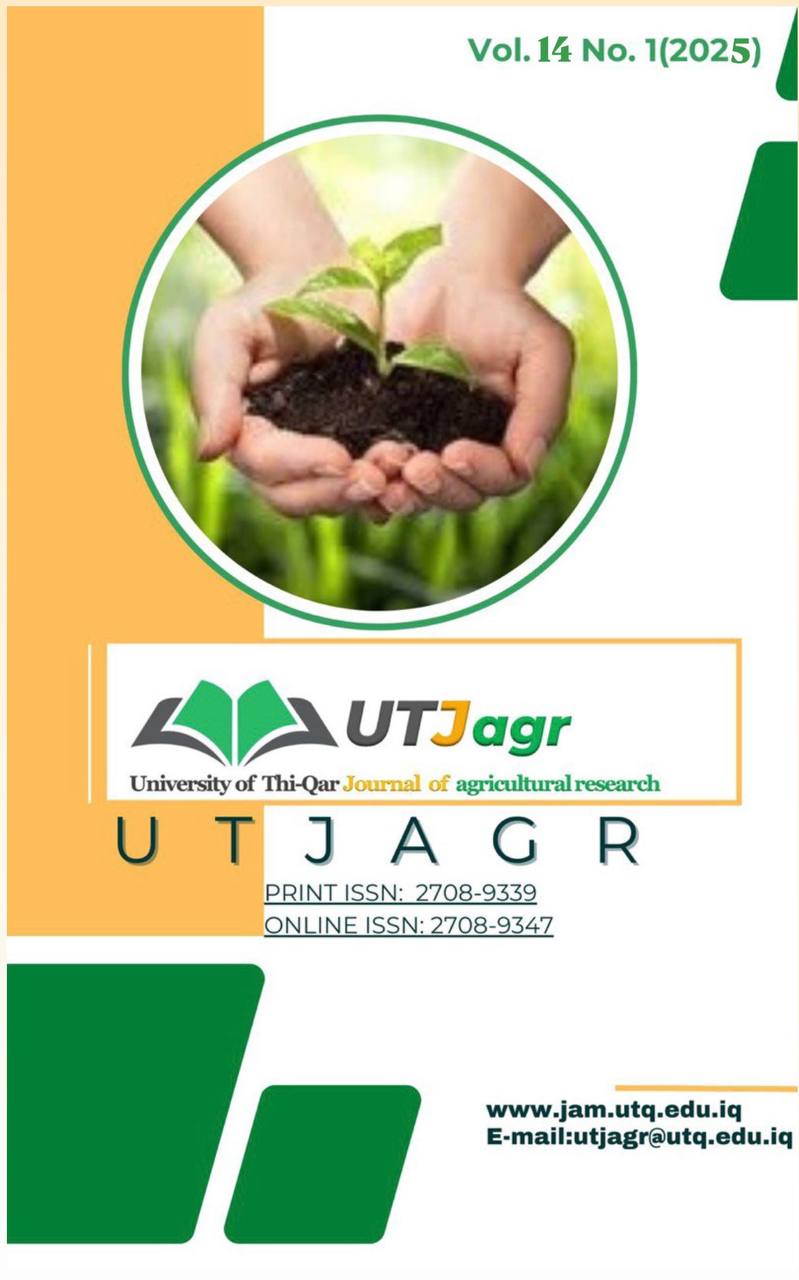Impact of using licorice root aqueous extract,.on Peking duck carcass
DOI:
https://doi.org/10.54174/a604h292Keywords:
ducks, carcass, licorice aqueous extractAbstract
The study conducted in one of the private fields for raising Peking ducks in Al-Muthanna Governorate, starting from 14/2/2025 to10/4/2025. 60 one-day-old Peking ducklings were raised from unsexed Peking ducks with an average weight of 42g. The ducklings were prepared from the local markets in Diwaniyah Governorate, to demonstrate the effect of studying different levels of aqueous extract of licorice on carcass of Peking ducks.
The chicks were randomly assigned to four treatments, each with three replicates (5 chicks per replica). They were placed in twelve pens. The trial consisted of the following treatments:
T1: Control treatment (no addition).
T2: 5 ml of licorice aqueous/ L
T3: 10 ml of licorice aqueous/ L
T4: 15 ml of licorice aqueous/ L
The results indicated the following:
The addition of licorice aqueous extract to the drinking water of Peking ducks resulted in remarkable improvement. In the researched production traits, body weight, weight gain, and feed conversion ratio improvement were examined. The fourth treatment, which used 15 ml of licorice aqueous extract per liter of drinking water, produced the best results.
The results showed a significant increase in the dressing percentage with and without edible viscera, the relative weight of edible viscera (giblet), and the relative weight of the main cuts, with a significant decrease in the secondary cuts of Peking duck carcasses treated with various levels of licorice aqueous extract, particularly at a concentration of 15 ml/liter of drinking water.
Downloads
References
Al-Daraji, Hazem Jabbar, Imad Al-Din Abbas Al-Ani, Sadiq Ali Taha, and Jassim Qasim Manati. 2003. The effect of adding licorice extract to drinking water on the percentages of pieces and some physical characteristics of broiler carcasses. Iraqi Journal of Agricultural Sciences. Vol. 34(5): pp. 208-219.
Al-Daraji. Hazem Jabbar, Imad Al-Din Al-Ani, Ali Hussein Khalil Al-Hilali, Jassim Qasim Manati and Inas Rashid Abbas. 2004. Using licorice extract to improve the productive performance of broiler chickens during the summer months. Iraqi Journal of Agricultural Sciences. Vol. 35(1).
Al-Fayyad, Hamdi Abdel Aziz and Saad Abdel Hussein Naji. 2012. Poultry Products Technology. Second Edition. Directorate of Higher Education Printing. Baghdad.
Hamza, Youssef Omar. 1999. Treatment with the Qur’an, Sunnah and Black Seed - Master’s Thesis in Agricultural Sciences, University of Baghdad.
Al-Daraji, Hazem Jabbar, Imad Al-Din Abbas Al-Ani, Jassim Qasim Manati and Hatem Issa Al-Hiti 2003. The effect of adding different concentrations of licorice extract to drinking water on the productive performance of broiler chickens. Iraqi Journal of Agricultural Sciences 197: (4)34-206.
Saad Laith Saree Al-Rikabi. 2017. Medicinal Plants, Department of Life Sciences, University of Al-Qadisiyah, p. 2
FAO, F. 2020. Gateway to poultry production and products. 2020. Food and agriculture organization of the United Nations.
Jassim, J. M., Mossa, R. K., Al-Assadi, M. H., & Gong, Y. 2011. Evaluation of physical and chemical characteristics of male and female ducks’ carcasses at different ages. Pakistan Journal of Nutrition
Madeleine, P. 2006. Marche francais et international du canard. Angers France, 10pp
Baéza, E. 2006. Effects of genotype, age and nutrition on intramuscular lipids and meat quality. In Symposium COA/INRA Scientific Cooperation in Agriculture. November (pp. 7-10)
Botsoglou, N. A., Yannakopoulos, A. L., Fletouris, D. J., Tserveni-Goussi, A. S., & Fortomaris, P. D. 1997. Effect of dietary thyme on the oxidative stability of egg yolk. Journal of Agricultural and Food Chemistry, 45(10), 3711-3716
Kim H. 2022.The Truth About Duck Farming .Retrieved at 7/3(January19,2022).
Lewis, M. R., Rose, S. P., Mackenzie, A. M., & Tucker, L. A. 2003. Effects of dietary inclusion of plant extracts on the growth performance of male broiler chickens. British Poultry Science, 44(S1), 43-44
Mossy, O. 2018. Duck diet: best foods for ducks .Retrieved at 7/3
Ramakrishna Rao, R., Platel, K., & Srinivasan, K. 2003. In vitro influence of spices and spice‐active principles on digestive enzymes of rat pancreas and small intestine. Food/Nahrung, 47(6), 408-412
Sivropoulou, A., Papanikolaou, E., Nikolaou, C., Kokkini, S., Lanaras, T., & Arsenakis, M. 1996. Antimicrobial and cytotoxic activities of Origanum essential oils. Journal of agricultural and Food Chemistry, 44(5), 1202-1205
Soufy, H., Yassein, S., Ahmed, A. R., Khodier, M. H., Kutkat, M. A., Nasr, S. M., and Okda, F. A. 2012. Antiviral and immune stimulant activities of glycyrrhizin against duck hepatitis virus. African Journal of Traditional, Complementary and Alternative Medicines, 9(3), 389-395
Al-Salhie, K. C. K., Shawket, T. F., & Lehmood, B. A. M. 2017. Effect of supplementation date palm pollen on some physiological and reproductive traits of Japanese quail birds (Coturnix Coturnix japonica). The Iraqi Journal of Agricultural Science, 48(6), 1389-1398
Demir, E., Kilinc, K., Yildirim, Y., Dincer, F., & Eseceli, H. 2008. Comparative effects of mint, sage, thyme and flavomycin in wheat-based broiler diets. Archiva zootechnica, 11(3), 54-63
Divakara, S. E., & Anandara, J. M. 2013. Cumin, fennel and fenugreek, soils, plant growth and crop production. Encyclopedia of life support systems).
Shabaan, M. 2012. Effect of using thyme (Thymus vulgaris L) and cumin (Cuminum cyminum L) seeds for improving the utilization of low energy broiler diet. Egyptian Poultry Science Journal, 32(3), 579-591.

Downloads
Published
Issue
Section
License
Copyright (c) 2025 alaa ahmed, haneen sattar

This work is licensed under a Creative Commons Attribution-NonCommercial-ShareAlike 4.0 International License.







1.png)

